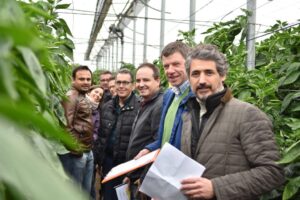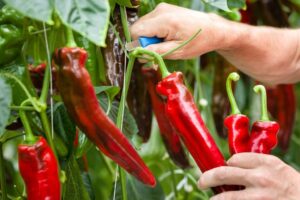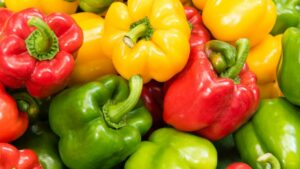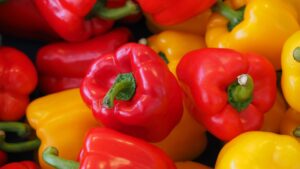In each issue, European Seed takes a closer look at one of the many crops that European plant breeders are working on. In this issue, we’re putting the sweet pepper in the spotlight and we have contacted leading breeders to learn about the breeding challenges and what kinds of innovations they are working on. The five industry experts are: Zoran Susic, Sweet Pepper breeder, Monsanto; Aernoudt Aardse, Crop Research Director, Enza Zaden; Matthieu Nicolas, Global Breeding Lead for Peppers, Syngenta; Natalia Nagy, Global R&D Team Lead Peppers, Bayer; and Jair Haanstra, Breeding Manager, Rijk Zwaan.
Origins and Market Share
The bell pepper (also called the sweet pepper or capsicum) is a cultivar of the species Capsicum annuum, which originated in Mexico, Central America and northern South America. Researchers at University of California (Davis) report that dried pepper fruits and seeds have been recovered from 9000 year-old burial sites in Mexico. Domestication might have taken place as early as 12,000 years ago, making peppers was one of the first crops in the Americas to be domesticated. Columbus brought dried peppers to Europe in 1493 and their use spread across the region and into Africa, Asia and North America. Today, China is the world’s largest pepper producer, followed by Mexico and Indonesia. The website ‘World’s Top Exports’ reports that global exports of sweet peppers and chili peppers totaled $5 billion USD during 2016, an average 14.7% increase over 2012. The site states that “Europe exported the highest dollar worth of peppers during 2016, with shipments valued at $2.5 billion (50.2% of total worldwide sales. In second place was North America at 35.2% while 10.6% of worldwide peppers shipments originated from Asian exporters.” Smaller percentages came from Africa, Latin America (excluding Mexico) and Oceania.
More stories to check out:
Sweet pepper is an increasing popular vegetable crop, available in several different types and colours. Please tell us about your breeding focus.
Zoran Susic (ZS): Peppers can be consumed fresh or processed, and hold an important position in menus of various regional kitchens in the world where a great diversity in type, size, colour and shape are preferred. We aim to deliver pepper hybrids with superior performance for the most broadly-grown types, which are blocky, followed by half-long (Lamuyo, typical for the markets in Spain and Italy) and various types of pointed peppers. Market size, growing area, type of growing system (protected heated glasshouse in central and northern Europe or unheated protected plastic house or open field in southern Europe) as well as planting dates are additional factors of importance that we take into consideration.
Aernoudt Aardse (AA): Our breeding efforts are focussed to improve yield, quality and reliability. When zooming in, there are differences among pepper types and within types in traits, objectives and priorities, depending on market needs and opportunities. For instance, to get a high-performing blocky pepper variety in the Netherlands or Spain requires a different product model because crop systems, seasons and growing conditions are different. In Europe, our main focus is on sweet pepper blocky and conical types for protected cultivation along with regional types including lamuyos.
Matthieu Nicolas (MN): The Syngenta pepper breeding R&D team is located in Spain, Netherlands, Israel, Mexico, US and Brazil. The breeding objectives are primarily focused at these major markets, but we also drive hard to serve other developing markets such as India, China, Mexico… We have narrowed our focus on blocky types for all ecologies (heated glasshouse, unheated plastic houses, open field dry, open field humid) and various elongated and conical types such as Elongated Bell and Dulce Italiano (plastic house) and Cascadura (open field).
Natalia Nagy (NN): There is a strong focus on blocky peppers in our organization, but we do keep a balance with other regional types and we breed for half-long (Lamuyos) peppers in southern Europe. We also have a strong R&D presence in Turkey, where we breed for local pepper types.
Jair Haanstra (JH): We choose to work on a broad assortment of peppers, as we believe that widening the category can contribute to a higher consumption of this product. In general, peppers must meet the expectations of consumers. For instance, blocky peppers should be really blocky. On the other hand, our customers ask for new, innovative types that give them the possibility to set themselves apart in the market. A good example of this is our Sweet Palermo innovation that is also extending in terms of colour (next to the red one, a yellow and orange are being introduced).
Specifically, colour preference can vary for each region. In Northwest Europe, consumers like their peppers to have a bright red colour, while in the south, they prefer a darker red. In some segments, taste is extra important, such as in Rijk Zwaan’s sweet Palermo type. When it comes to snack peppers that are becoming more popular, breeding for sweetness is important but they should also be crunchy and juicy, with not too many seeds and the skin should not stay lingering in your mouth when chewing. Another example is the Dolma, very popular in Turkey and often prepared in the oven. The skin should not be too thick, or the cooking time is too long.

In most crops, yield and resistance are paramount breeding targets. How is this in sweet pepper?
ZS: Like with other crops, yield is an important breeding target in peppers, but resistance to a wide variety of diseases and fruit quality remain primary objectives of breeding. Resistance or tolerance to any kind of stress, biotic or abiotic, is essential for stable performance.
AA: Yield is crucial for the grower to be competitive, but goes hand-in-hand with fruit quality and a good resistance package to reduce pesticide use and secure the yield for the grower. We can offer a high-producing variety but when fruits are sensitive to micro-cracking or lack shelf-life, the variety will have no value. Value can also be created aiming to reduce costs; for instance, a grower can save costs by having a variety that is more labour-friendly. Over the last decade, yields have increased 10 per cent. This achievement is the combined result of breeding efforts and crop/greenhouse advancements. Taking into account the long growing cycle and highly-controlled conditions, yields in the heated high-tech greenhouses in North West Europe can be up to three times higher compared to the un-heated plastic greenhouses in Southern Europe.
NN: Many of the breeding efforts are the same for the different types of sweet peppers like yield and certain diseases. The difference is how yield manifests itself. In some markets yield is represented by the amount of peppers, and in others, it is measured by kg per m2, or by fruit weight and fruit dimensions. These parameters need to be kept in mind when improving yield. In general breeding increases yield about 1 per cent per year.
JH: Obviously, yield is a very important breeding goal, but it also depends on the market segment. In Dutch high-tech greenhouses where peppers are grown under maximum-controlled circumstances, every kilo is important. When a variety gives 0.5 kilo more yield, it can already have an important, positive effect on the profits of a grower. In this high-tech market, the yield increase per year is around 1 or 2 per cent. In markets with a lower technical level (especially open field production), it is especially important to have a stable production. With unexpected and/or extreme climate conditions, growers still want to produce a good/sufficient yield.
In every market and segment, resistance breeding is very important, but insects and diseases differ per region. In general, we can say that this breeding goal gets more important as sustainability is gaining importance and retailers set higher demand in terms of the use of chemical crop protection.
[tweetshare tweet=”In markets with a lower technical level, it is important to have a stable production.” username=”EuropeanSeed”]
Which diseases are most important in your breeding work? Have there been any new diseases in sweet pepper in the past few years?
ZS: The set of disease resistances required to grow pepper varieties are defined by growing area as well as type of growing system. In general, less complex disease packages are necessary in the heated glasshouse market (resistances to Tobacco Mosaic Virus and Tomato Spotted Wilt Virus). In addition to these virus resistances, in the unheated protected areas in the south of Europe, resistance to Powdery Mildew and Nematodes, as well insect resistance (Bemisia tabaci and Thrips) are of increasing importance.
AA: In Europe, the most troublesome diseases include pepper mild mottle viruses, tospo viruses, powdery mildew (Leveillula taurica) and root-knot nematodes (Meloidogyne sp.). The listed diseases are especially important for the Southern Europe production regions and organic cultivations. Internal fruit rot (Fusarium lactis) gets a lot of attention in the high-tech pepper cultivation in northwest Europe. In recent years, pepper vein yellows virus has been problematic in the Mediterranean region.

MN: Our breeding projects for resistance against many diseases and pests are very long term, sometimes taking more than 15 years, between the initial cross with the exotic resistant material and the released commercial variety. This is why we are very proud that most of our future varieties will be resistant to pests such as Nematodes (Meloidogyne sp.) and Powdery mildew (Leveilulla taurica), with native resistance traits coming from wild peppers. The list of resistances we are addressing is long: Phytophtora, Tospoviruses, Tobamoviruses, Xanthomonas and many more. In addition, we are just launching a white fly resistant variety. Breeding for insect resistance is a battle fought on two fronts: providing resistance against the pest itself (white flies, thrips, caterpillars) to reduce virus pressure as the pest act as vectors for the virus, and creating resistance to the virus itself as well.
[tweetshare tweet=”It takes about eight years to produce a new pepper variety.” username=”EuropeanSeed”]
What is the biggest challenge for a breeder when developing a new sweet pepper variety?
ZS: Be innovative and faster than the competition.
AA: A big challenge is improving traits that are complex in nature, traits that constitute multiple genetic factors and/or are sensitive to environmental and growing conditions: yield, adaptability, (a)biotic stresses and shelf-life, to name a few.
NN: A breeder needs to combine external market information originating from various channels like plant raisers, growers, chain and the end consumer with internal vision on how the market will develop. The breeder has to have good relationships with the internal marketing and sales organization to hear developments outside the company.
JH: The biggest challenge for a pepper breeder is to take in account and balance all the different wishes of all the different industry players. What makes it extra important is the increasing regulatory pressure. This includes more stringent phytosanitary regulation, but also making sure that all material that we use in breeding is not conflicting with regulations on intellectual property and/or access and benefit sharing.
Do you find that you have sufficient access to new germplasm, or has this been made more difficult because of the new regulations on access and benefit sharing?
ZS: Monsanto fully supports the aims of the Convention on Biological Diversity, and our policies and procedures for germplasm acquisition, use and sharing of externally-acquired material are in full compliance with the requirements and obligations under ABS laws. Nevertheless, further guidance and clarity on various issues (such as clear definition of genetic resources and R&D within scope) need to be provided by the regulators or national authorities in various countries.
Therefore, Monsanto supports cooperative efforts on the part of the industry and regulatory agencies to ensure that the pathway to compliance is clear, simple and as non-disruptive as possible.

AA: The access to new germplasm is regulated by country-specific regulations worldwide as well as the European access and benefit-sharing regulation. Currently there are legal uncertainties due to missing information on the access and benefit-sharing clearing house website, which makes the access to new germplasm more difficult. The multiple legislations should be clear and accessible in English and there should be a practical pathway provided on how to access germplasm and how to negotiate the conditions of use.
NN: Access to new germplasm is indeed becoming more and more difficult due to new regulations. The Nagoya Protocol is putting pressure on the parties of the Convention on Biological Diversity to create more clarity on national access and benefit-sharing regulations. This means we have to comply with an increasing number of national regulations, which quite often do not take into account the specifics of the plant-breeding sector, where many genetic resources are used to create new genetic resources. We especially struggle in those cases where the scope of the regulations is expanded beyond wild plants and landraces, and countries claim sovereign rights over commercial varieties that were developed by private breeding companies.
JH: Unfortunately, discussions about access to genetic variation only too often end in a discussion about money. It’s a continuous challenge to explain that collection trips help preserving agrobiodiversity and contribute to better vegetable varieties for local growers. Therefore, we are building international networks of genebanks and governments and we actively start dialogues with local authorities.
[tweetshare tweet=”Discussions about access to genetic variation often ends in a discussion about money” username=”EuropeanSeed”]
MN: Innovation is the core motivation of every breeder and access to genetic diversity is key for innovation. This has never been a blocker for us, as we have large internal wild collections, and also access to national gene banks, but we are eager to see clear access and sharing guidelines implemented.
What are the innovations (technological, genetic, molecular etc.) which are in the pipeline in sweet pepper breeding?
AA: One of the areas we foresee opportunities for the growers is the use of rootstocks in pepper. Although still at the infant stage, they have the potential to become common practice, as is the case in tomato. As Enza Zaden is investing a lot in technology development, more molecular breeding tools are available which give breeders the opportunity to better understand and select for these complex traits.
MN: New colours, new shapes, new tastes, higher digestibility are some examples for our future diversification pipeline. We recently released the first seedless snack pepper with enhanced taste and we intend to follow up with a full product line (red, orange, yellow, green) to entertain our consumers.













